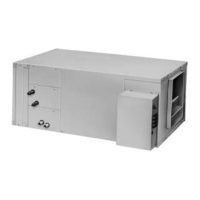BCXC-SVX01A-EN 47
Maintenance
Maintenance
Procedures
Keep coils clean to maintain maximum
performance. For operation at its highest
efficiency, clean the coil often during
periods of high demand or when dirty
conditions prevail. Clean the coil a
minimum of once per year to prevent dirt
buildup in the coil fins, where it may not
be visible.
Remove large debris from the coils and
straighten fins before cleaning. Remove
filters before cleaning. Rinse coils
thoroughly after cleaning.
Clean the coil fins using one of these
methods:
• steam with detergent
• hot water spray and detergent
• commercially available chemical coil
cleaner
CAUTION
Potential unit damage from coil
cleaners!
Do not use acidic chemical coil
cleaners. Also, do not use alkaline
chemical coil cleaners with a pH value
greater then 8.5 (after mixing) without
using an aluminum corrosion inhibitor
in the cleaning solution. Using these
type cleaners may cause unit
damage.
Inspecting and Cleaning Coils
Coils become externally fouled as a
result of normal operation. Dirt on the coil
surface reduces it’s ability to transfer
heat and can cause comfort problems,
increased airflow resistance and thus
increased operating energy costs. If the
coil surface dirt becomes wet, which
commonly occurs with cooling coils,
microbial growth (mold) may result,
causing unpleasant odors and serious
health-related indoor air quality
problems.
Inspect coils at least every six months or
more frequently as dictated by operating
experience. Cleaning frequently is
dependent upon system operating hours,
filter maintenance, and efficiency and dirt
load. Follow is the suggested method
below:
Steam, Hot Water, and Cooling Coil
Cleaning Procedure
1.Don the appropriate personal
protective equipment (PPE).
2. Gain access to both sides of the coil
section.
3. Use a soft brush to remove loose
debris from both sides of the coil.
4. Use a steam cleaning machine, starting
from the top of the coil and working
downward. Clean the leaving air side of
the coil first, then the entering air side.
Use a block-off to prevent steam from
blowing through the coil and into a dry
section of the unit.
5. Repeat step 4 as necessary. Confirm
that the drain line is open following
completion of the cleaning process.
7. Allow the unit to dry thoroughly before
putting the system back into service.
8. Straighten any coil fins that may be
damaged with a fin rake.
9. Replace all panels and parts and
restore electrical power to the unit.
10. Ensure that contaminated material
does not contact other areas of the unit
or building. Properly dispose of all
contaminated materials and cleaning
solutions.
WARNING
Hazardous chemicals!
Some chemical coil cleaning
compounds are caustic or toxic. Use
these substances only in accordance
with the manufacturer’s instructions.
Failure to do so may cause equipment
damage, injury, or death.
Winterizing the Coil
Make provisions to drain coils that are not
in use, especially when subjected to
freezing temperatures.
To drain the coil, first blow out the coil
with compressed air. Next, fill and drain
the tubes with full-strength ethylene
glycol several times. Then drain the coil
as completely as possible.
CAUTION
Potential coil-freeze condition!
Make provisions to drain the coil when
not in use to prevent coil freeze-up.

